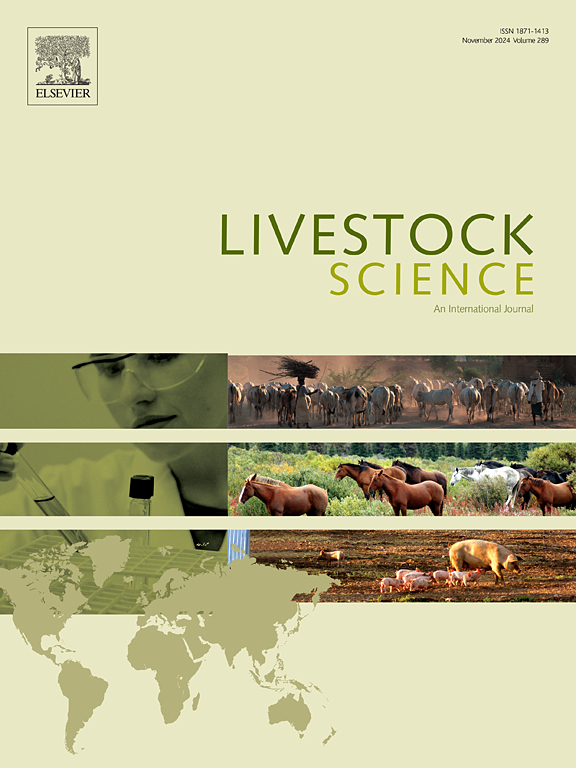Effect of enriched biochar on methane emissions, rumen microbial structure and rumen fermentation characteristics in Holstein steers
IF 1.8
3区 农林科学
Q2 AGRICULTURE, DAIRY & ANIMAL SCIENCE
引用次数: 0
Abstract
Nutritional strategies, such as oil inclusion or addition of 3-Nitrooxypropanol, to reduce methane emissions from ruminants show promise, but have not been as effective in low quality or roughage based diets. The objective of this study was to investigate the effect of enriched biochar on methane production and fermentation characteristics in an oaten hay diet. This study used a 3 × 3 Latin square design, where 3 fistulated Holstein steers (790 ± 100 kg initial body weight) were fed a basal diet of oaten hay, with either 1) oaten pellets (Control), 2) Oaten pellets containing biochar at 1 % of dietary DM; or 3) Oaten pellets containing enriched biochar at 1 % DM. Each period lasted for 21 d, including 14 d dietary adaptation and 7 d experimental measurement. Rumen samples were collected on d 17–21 for determination of liquid and solid associated microbes, and rumen fermentation characteristics. The sulphur hexafluoride (SF6) tracer technique was used to quantify methane emissions. Body weights (kg), dry matter and organic matter intakes (DMI and OMI), methane production (g/d), methane intensity (g kg-1 BW) and methane yield (g kg-1 DMI) were similar (P ≥ 0.12) across the three treatment groups. Similarly, total VFA concentration and individual percentages of VFA were similar across treatments (P ≥ 0.16). Microbes in the solid and liquid fractions showed little differences among treatments (P ≤ 0.049) indicating that biochar included in an oaten hay diet, whether standard or enriched, had little effect on rumen fermentation, microbial communities or methane emissions in Holstein steers.
富集生物炭对荷斯坦牛甲烷排放、瘤胃微生物结构和瘤胃发酵特性的影响
营养策略(如含油或添加 3-硝基氧基丙醇)可减少反刍动物的甲烷排放,但在低质量或以粗饲料为基础的日粮中效果不佳。本研究的目的是调查富集生物炭对燕麦干草日粮中甲烷产量和发酵特性的影响。本研究采用 3 × 3 拉丁正方形设计,给 3 头拳头大小的荷斯坦阉牛(初始体重为 790 ± 100 千克)饲喂燕麦干草基础日粮,同时添加 1) 燕麦颗粒(对照组)、2) 含有生物炭的燕麦颗粒(占日粮 DM 的 1%)或 3) 含有富集生物炭的燕麦颗粒(占日粮 DM 的 1%)。每个阶段持续 21 天,包括 14 天的饮食适应期和 7 天的实验测量期。在第 17-21 天收集瘤胃样本,以测定液态和固态相关微生物以及瘤胃发酵特性。六氟化硫(SF6)示踪技术用于量化甲烷排放量。三个处理组的体重(千克)、干物质和有机物质摄入量(DMI 和 OMI)、甲烷产量(克/天)、甲烷强度(克/千克-1 体重)和甲烷产量(克/千克-1 DMI)相似(P ≥ 0.12)。同样,各处理组的总挥发性脂肪酸浓度和挥发性脂肪酸的单个百分比也相似(P ≥ 0.16)。固态和液态部分的微生物在不同处理中几乎没有差异(P ≤ 0.049),这表明燕麦干草日粮中的生物炭,无论是标准的还是富集的,对荷斯坦牛的瘤胃发酵、微生物群落或甲烷排放都没有什么影响。
本文章由计算机程序翻译,如有差异,请以英文原文为准。
求助全文
约1分钟内获得全文
求助全文
来源期刊

Livestock Science
农林科学-奶制品与动物科学
CiteScore
4.30
自引率
5.60%
发文量
237
审稿时长
3 months
期刊介绍:
Livestock Science promotes the sound development of the livestock sector by publishing original, peer-reviewed research and review articles covering all aspects of this broad field. The journal welcomes submissions on the avant-garde areas of animal genetics, breeding, growth, reproduction, nutrition, physiology, and behaviour in addition to genetic resources, welfare, ethics, health, management and production systems. The high-quality content of this journal reflects the truly international nature of this broad area of research.
 求助内容:
求助内容: 应助结果提醒方式:
应助结果提醒方式:


